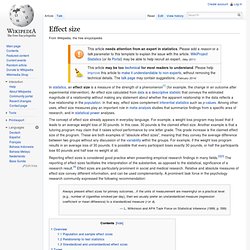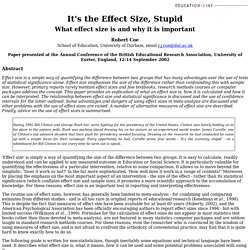

Effect size. In statistics, an effect size is a measure of the strength of a phenomenon[1] (for example, the change in an outcome after experimental intervention).

An effect size calculated from data is a descriptive statistic that conveys the estimated magnitude of a relationship without making any statement about whether the apparent relationship in the data reflects a true relationship in the population. In that way, effect sizes complement inferential statistics such as p-values. Among other uses, effect size measures play an important role in meta-analysis studies that summarize findings from a specific area of research, and in statistical power analyses. The concept of effect size already appears in everyday language. For example, a weight loss program may boast that it leads to an average weight loss of 30 pounds. Overview[edit] Population and sample effect sizes[edit] being the estimate of the parameter Relationship to test statistics[edit] Standardized and unstandardized effect sizes[edit] or.
Effect Size for Paired T-test. It's the effect size, stupid: what effect size is and why it is important. It's the Effect Size, StupidWhat effect size is and why it is important Robert CoeSchool of Education, University of Durham, email r.j.coe@dur.ac.uk Paper presented at the Annual Conference of the British Educational Research Association, University of Exeter, England, 12-14 September 2002 Abstract Effect size is a simple way of quantifying the difference between two groups that has many advantages over the use of tests of statistical significance alone.

Effect size emphasises the size of the difference rather than confounding this with sample size. 'Effect size' is simply a way of quantifying the size of the difference between two groups. The routine use of effect sizes, however, has generally been limited to meta-analysis - for combining and comparing estimates from different studies - and is all too rare in original reports of educational research (Keselman et al., 1998). 1. The average score was 15.2 for the morning group, 17.9 for the afternoon group: a difference of 2.7. (a) (b) 2. Effect Size Calculators - Effect Size (ES) Effect Size Calculator. What It Does This calculator evaluates the effect size between two means (i.e., Cohen's d; Cohen, 1988), which is the difference between means divided by standard deviation.

Between-subjects Studies Enter the two means, plus SDs for each mean. To compute effect size using pooled or control condition SD, only enter one SD (computed as appropriate, of course). Within-subjects Studies For within-subjects studies, one must correct for dependence among means in order to make direct comparisons to effect sizes from between-subjects studies.
Calculator for Means and SDs downloadable Excel version Calculation Using t score Alternatively, enter the t score and sample size for each condition. Calculator for t scores and Sample Sizes Choice of SD Term I prefer to use the average of each mean's individual SD, as opposed to pooled or control condition SD. What to Report Report the d value that gets output from this calculator. Why Report Effect Sizes Why Make a Calculator References Cohen, J. (1988). Morris, S.